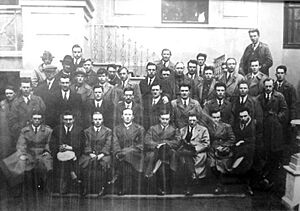Tom McEllistrim (1894–1973) facts for kids
Quick facts for kids
Tom McEllistrim
|
|
|---|---|
| Teachta Dála | |
| In office July 1937 – June 1969 |
|
| Constituency | Kerry North |
| In office August 1923 – July 1937 |
|
| Constituency | Kerry |
| Personal details | |
| Born | 14 October 1894 Listowel, County Kerry, Ireland |
| Died | 4 December 1973 (aged 79) Tralee, County Kerry, Ireland |
| Political party | Fianna Fáil |
| Spouse |
Sheila Leary
(m. 1919) |
| Relations | Tom McEllistrim (grandson) |
| Children | 3, including Tom |
| Military service | |
| Allegiance |
|
| Years of service | 1916–1923 |
| Battles/wars | |
Thomas McEllistrim (born October 14, 1894 – died December 4, 1973) was an important Irish politician. He was a member of the Fianna Fáil political party. He served as a Teachta Dála (TD), which is like a member of parliament in Ireland, from 1923 to 1969. Before becoming a politician, he was involved in military actions from 1916 to 1923.
Contents
Early Life and Fighting for Ireland
Tom McEllistrim joined the Irish Volunteers in 1914. This group worked for Irish independence. He was involved in a plan by Roger Casement to bring weapons into Ireland for the Easter Rising. This plan happened at Banna Strand in County Kerry.
After the Easter Rising in 1916, the British government held him in a camp called Frongoch internment camp in Wales. This was because of his role in the events.
In April 1918, Tom McEllistrim led a raid to get weapons from a police station in Gortatlea. This was one of the first acts of guerrilla warfare in Ireland. Guerrilla warfare is a type of fighting where small groups use surprise attacks and quick retreats.
Fighting in the War of Independence
McEllistrim was a key figure in the Irish Republican Army (IRA) in Kerry. This was during the Irish War of Independence from 1919 to 1921. He helped create an "Active Service Unit" in June 1920. Later, he helped form a larger "flying column" in early 1921. A flying column was a full-time group of fighters who moved quickly.
His column fought in important battles like the Clonbanin Ambush and the Headford Ambush in 1921. During the Headford Ambush, the IRA attacked a train carrying British soldiers. The leader of the flying column, Dan Allman, was killed. Tom McEllistrim then took command of the group.
Historians say that Tom McEllistrim played a very important role in the War of Independence. He was as important as other famous fighters like Tom Barry. However, he never wrote a book about his experiences. He also rarely spoke about them in public, even when he was a TD for over 40 years.

Role in the Civil War
Tom McEllistrim did not agree with the Anglo-Irish Treaty. This treaty created the Irish Free State but also divided many Irish people. Because he rejected the treaty, he fought with the Anti-Treaty IRA during the Irish Civil War (1922-1923).
He was one of the main IRA leaders in Kerry during this conflict. At the start of the war, he led a group of fighters from Kerry in battles in Limerick. This included the Battle of Kilmallock. After these battles, his group went back to Kerry and continued their guerrilla fighting. In January 1923, he led an attack on a National Army barracks in Castlemaine. They used a special homemade weapon called an "improvised mortar."
Political Career in the Dáil
Just a few months after the Civil War ended, Tom McEllistrim was elected as a TD for Kerry in August 1923. He ran as a republican candidate. He received a good number of votes and became a TD.
He continued to serve as a TD for the Kerry area. Later, from 1926 to 1969, he represented Kerry North. After 1926, he joined many other republican leaders in the Fianna Fáil political party.
His son, Tom McEllistrim, also became a TD for Kerry North. His grandson, also named Tom McEllistrim, later represented the same area. This shows a family tradition of serving in Irish politics.
See also
- Families in the Oireachtas

